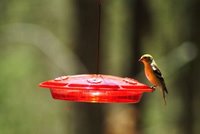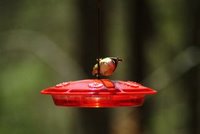Trees Full of Warblers
Monday, April 28th, 2008Early this morning, I heard a familiar bird song – please-please-pleased to MEET-cha. Sure enough, when I went out onto the back deck, there were at least two Chestnut-sided Warblers singing in the lower branches of the white oaks – along with Blackpoll, Black-and-White, Parula, Yellow-rumped and Pine Warblers, and a Red-eyed Vireo. The trees jangled like a soft tambourine with song, and the singers flitted in and out of sight among the new-green leaves dripping with rainwater.
The two Chestnut-sided Warblers looked vivid in crisp, saturated colors. The chestnut streaks on either side gleamed dark, almost wine-red, especially against the white of the breast. With a prominent gold crown, white cheeks, black moustache stripes, a black stripe through the eye, and two white wing bars, a Chestnut-sided Warbler is one of the most colorful of all the wood warblers, both to see and to hear. Its song isn’t loud, but it’s quick and expressive, and easy to learn.
Several Blackpoll Warblers – more subtle in both coloring and song – flitted in and out of sight among the leaves. In their spring plumage, each male is a study in black, white and gray, with coal-black cap, white throat, black moustache stripes, and white cheeks that look like broad white crescents, two white wing bars, and black streaks on the sides and back. I could not hear their very high tsit-tsit-tsit-tsit-tsit song, but maybe it was just hard to pick out among all the others.
I did hear the song of one Black-throated Blue Warbler from down in some thickets on the edge of a neighbor’s yard, a buzzy, metallic zoo-zoo-zoo-ZREE – and wished I could have seen it, but did not. The Chestnut-sided, Blackpoll, and Black-throated Blue Warblers all are just passing through, on their way further north, and the Yellow-rumped Warblers, which have been with us all winter, will soon be moving north, too.

